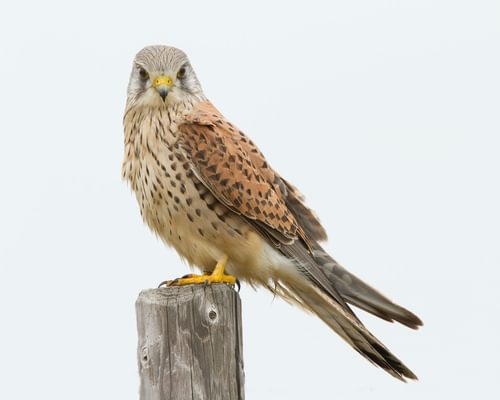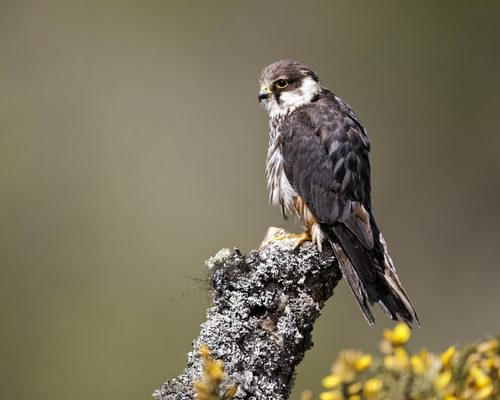Peregrine Falcon
Least ConcernFalco peregrinus
Visual Identification
Appearance
The Peregrine Falcon is a striking raptor with a blue-grey back, barred white underparts, and a black head with distinctive facial markings. It has a hooked beak and powerful yellow legs with sharp talons.
Females are often darker than males but otherwise very similar in plumage. However, they are noticeably larger than males, often by up to 30%.
Juveniles have brown upperparts and streaked underparts, gradually moulting into adult plumage over their first year. Young birds are also streaked rather than barred below and have blueish (not yellow) skin around their eyes and the base of their bill.
Size
Length
34cm to 58cm
Wingspan
74cm to 120cm
Weight
330g to 1.5kg
Colours
Males and females have similar plumage
Primary Colour
Blue Grey
Secondary Colour
White Black
Beak Colour
Black Grey Yellow
Leg Colour
Yellow
Special Accolade
Fastest Flying Bird
Recorded as the fastest bird in level flight
Record: 389 km/h (242 mph) diving speed
Habitat and Distribution
Habitats
Woodland
Garden
Wetland
Coastal
Urban
Farmland
Grassland
Desert
Tundra
Rainforest
Mountain
Savanna
Distribution
Peregrine Falcons have a nearly worldwide distribution, absent only from Antarctica. They inhabit a wide range of environments, from Arctic tundra to tropical forests and, increasingly, urban areas.
They are right at home in many modern cities where rooftops and ledges make ideal nest sites, and feral Rock Doves provide a year-round food source.
In North America, they breed across Alaska and northern Canada, with populations in the western mountains and along both coasts. European populations are found from the UK to Russia, while they also occur across Australia and New Zealand.
Elevation Range
Sea level to 3,300 meters
Climate zones
Temperate, Arctic, Subtropical, Tropical
Distribution Map
This map gives you a rough idea of where you might spot a Peregrine Falcon. The coloured areas show countries where these birds have been seen.
A few things to keep in mind:
- Birds might not be everywhere in the coloured areas, for example, they may be present around the coast of that country
- Where birds live can change with seasons and available food
- This map is quite simple - it doesn't show exact locations
We're working on making our maps even better! Soon, we hope to show you:
- More detailed maps for bigger countries, including state and region
- How birds move around during different seasons
Distribution by Region
Behaviour and Ecology
Bird Attributes
This feature is in beta. We'd love your feedback to improve it!
Share your thoughtsBird Attributes Explained
Our bird attributes system rates various aspects of a bird's capabilities on a scale of 0-100, based on data from field observations, scientific studies, and expert knowledge.
Attribute Categories:
- Agility: Manoeuvrability, speed, and grace in flight or movement.
- Strength: Physical power, often correlating with size and hunting abilities.
- Adaptability: Ability to thrive in various environments or changing conditions.
- Aggressiveness: Territorial behaviour and assertiveness, particularly during breeding seasons.
- Endurance: Stamina, often seen in migration patterns or foraging behaviours.
Understanding the Ratings:
- 0-20: Very Low
- 21-40: Low
- 41-60: Average
- 61-80: High
- 81-100: Very High
Remember, these attributes are relative to other bird species and don't necessarily indicate superiority.
Hover over the icon next to each attribute for more information.
Tap the icon next to each attribute for more information.
Agility
Reflects the bird's manoeuvrability, speed, and grace in flight or movement.
The Peregrine Falcon's agility is exceptional, as evidenced by its ability to perform high-speed hunting dives reaching over 320 km/h (200 mph) and execute precise mid-air catches. Their pointed wing shape and aerial manoeuvrability make them one of the most agile birds in the world.
Strength
Indicates the bird's physical power, often correlating with size and hunting abilities.
Whilst not the largest raptor, Peregrine Falcons possess remarkable strength relative to their size. They can take down prey larger than themselves and carry substantial weights in flight. Their powerful legs and sharp talons enable them to strike and grip prey effectively.
Adaptability
Represents the bird's ability to thrive in various environments or changing conditions.
Peregrine Falcons demonstrate high adaptability, thriving in diverse habitats from Arctic tundra to tropical forests and even urban environments. Their ability to nest on both natural cliff faces and man-made structures further showcases their adaptiveness.
Aggressiveness
Measures the bird's territorial behaviour and assertiveness, particularly during breeding seasons.
These falcons exhibit considerable aggressiveness, particularly in hunting and territorial behaviour. Their high-speed hunting dives and willingness to take on a variety of prey, including other birds in mid-flight, indicate a notably aggressive nature.
Endurance
Reflects the bird's stamina, often seen in migration patterns or foraging behaviours.
Peregrine Falcons display impressive endurance, capable of long-distance migrations and sustained high-speed flight. Their ability to spot prey from over 3 km away and maintain the energy for rapid dives and pursuits demonstrates significant stamina and endurance.
Diet
Peregrine Falcons primarily hunt medium-sized birds, from pigeons to ducks, catching them in mid-air with their talons. They occasionally take small mammals and bats.
They are known to feed on hundreds or even thousands of different birds, ranging in size from Hummingbirds to Snow Geese and everything in between!
These falcons employ spectacular high-speed dives to strike their prey, often plucking birds out of the sky.
Behaviour
Peregrine Falcons are renowned for their high-speed hunting dives, or stoops, reaching speeds over 320 km/h (200 mph). They are solitary birds, only coming together during breeding season.
These falcons exhibit strong site fidelity, often returning to the same nesting locations year after year.
Vocalisation
Peregrine Falcons have a range of vocalisations, including a higher-pitched ‘chi chi chi’ and a loud, rapid 'kak-kak-kak' used as an alarm call or during territorial disputes.
During courtship, they produce a softer 'eechup' sound. When agitated, they may emit a high-pitched, piercing scream.
Nesting & Breeding
Peregrine Falcons typically form monogamous pairs, engaging in elaborate aerial courtship displays during late winter or early spring. They do not build nests but rather scrape a depression on cliff ledges or use existing structures.
Females lay 3-4 eggs, which are reddish-brown in colour. Both parents share incubation duties, which last about 29-32 days. The eggs are oval and measure about 5 cm in length.
Chicks fledge at 35-42 days old but remain dependent on their parents for several more weeks as they perfect their flying and hunting skills.
Lifespan
The Peregrine Falcon typically lives for 5 to 6 years, with a maximum recorded lifespan of 25 years.
Like all birds, lifespan can be affected by factors including predation, habitat quality, disease, and access to food sources.
Conservation and Status
Global Conservation Status
Peregrine Falcons have made a remarkable recovery since the ban of DDT in many countries. However, they still face threats from habitat loss, illegal hunting, and collisions with man-made structures.
Ongoing conservation efforts focus on nest site protection and urban habitat management.
Birdwatching Tips
- Look for Peregrines near cliff faces or tall buildings in urban areas
- Observe their distinctive, pointed wing shape during flight
- Listen for their loud, repetitive 'kak-kak-kak' calls
- In coastal areas, watch for their high-speed dives towards water birds
- Use a spotting scope to view distant perched birds on high ledges
Additional Information
Quick Facts
Other names:
Duck Hawk
Family:
FalconidaePredators
Adult Peregrine Falcons have few natural predators, but eggs and chicks may fall victim to large owls, eagles, and climbing mammals like raccoons.
Did You Know?
- Peregrine Falcons can spot prey from over 3 km away.
- They have been recorded diving at speeds of up to 389 km/h (242 mph), making them the fastest animals in the world (National Geographic TV program).
- Peregrine Falcons have been used in falconry for over 3,000 years.
- Seabirds are an important component of the Peregrine Falcon diet, particularly for coastal populations.
Was this bird profile helpful?
Your feedback helps us improve our content
Thanks for your feedback!
Your input helps us improve our content.
Community Experience
Community Ratings
1 rating from birders
Latest Community Reviews
Kevin Middlebrook
Community Reviews
Create Your Free Account Welcome Back!
Join our community to rate birds and share your experiences. Creating an account is completely free and only takes a minute. Sign in to your account to rate birds and share your experiences with our community.
Your information is secure and will never be shared.
By creating an account, you agree to our Privacy Policy.
FAQs
What time of day do Peregrines hunt?
Peregrine Falcons are naturally diurnal birds that may hunt at any time of the day, with peaks in the morning and late afternoon. They may hunt bats in the twilight of dawn and dusk and even use artificial light to hunt at night in urban areas.
Similar Birds
References
- 2 3 4
website: BirdLife International. 2021. Falco peregrinus. The IUCN Red List of Threatened Species 2021: e.T45354964A206217909.
View source - 1
book, 1980: John Terres, The Audubon Society Encyclopedia of North American Birds

